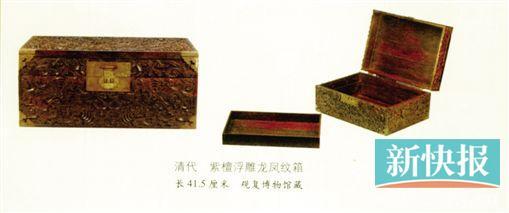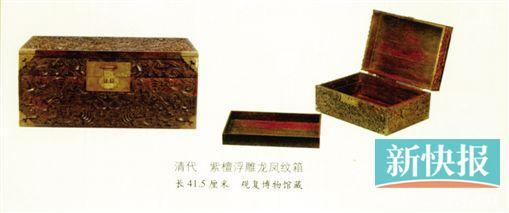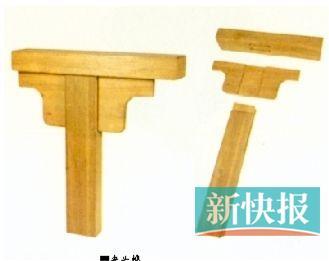Rosewood furniture materials reflect the court luxury
Qing Qianlong red sandalwood passion flower armchair high 108 cm view complex museum The red sandalwood embossed dragon and phoenix box in the Qing Dynasty Chuck 榫 Palace furniture in the Qing Emperor Qianlong was influenced by Western decorative style. Ma Weidu Guan Fu Museum Director Chinese classical furniture has a simple beauty. As people's living standards improve, people's love for classical furniture is also heating up. Chinese classical furniture is of excellent quality, and people are more familiar with red sandalwood, huanghuali, mahogany and nanmu. These precious materials can be seen in the market all over the country today. Lactational Pillow,G Pregnancy Pillow,Animal Shape,Silk Screen Cotton Cushion Jinan Huatian Leinuo Trade Corporation Ltd. , https://www.huatianleinuo.com




Red sandalwood is the most high-quality material in Chinese classical furniture. It was used in the royal period in the long history. The folk is very rare, noble, scarce, and high price is synonymous with it. Red sandalwood is a very important kind of wood, and in the Chinese material view, the heavier it is, the more valuable it is. Therefore, the Chinese generally love the furniture made of hardwood such as red sandalwood, huanghuali and mahogany.
This is a red sandalwood armchair (left) made by the court of the Qianlong period of the Qing Dynasty. It is greatly influenced by the western decorative style, and the whole is curved. This decorative style is very similar to the European Renaissance Rococo style, especially the splicing part, which is consistent with the details of the western chairs. The overall frame structure retains the basics of Chinese furniture, only some of them are made in some parts. change.
The traditional Chinese chair's backboard and handrails are straight (as shown on the left), while its backboard and handrails are curved, and there is a drop in the middle of the handrail to make the chair look very beautiful. To present a large number of curves and gaps, the wood needed is not very important, and the materials should be particularly particular. This piece of furniture is not very heavy, but the material is very large, showing the strength of the country at that time and the luxury of the court.
The red sandalwood utensils are made of bas-reliefs for saving materials. The picture below is a small box of purple sandal carved dragon wind (lower left). It has a drawer (tray) inside, which is used to hold the soft, and the part under the drawer can be used to collect treasures.
The red sandalwood grows slowly and is relatively dense. Under normal circumstances, it does not grow too big. This piece of red sandalwood box is not willing to use large materials when using materials. It is spliced ​​with small pieces. A total of 5 small pieces are used, and the method of oblique stitching is used for straightening. This is to make the best use of it. Use, because the material is very precious.
This piece of red sandalwood is thicker and thicker, and the wall thickness is more than one centimeter. The cover of the box is high-relief, with a clear dragon pattern; the front is engraved with two corresponding phoenix patterns; the back is the same as the front, and the phoenix is ​​symmetrically carved on both sides. The carving technique is deep relief. Usually, the red sandalwood utensils use bas-relief to save wood, so as to avoid waste and reduce weight.
This piece of red sandalwood was made during the Qianlong period of the Qing Dynasty. The exquisite craftsmanship of the carvings, together with the heavy plates, is enough to see its value.
Guan Fu School 1
What is the proportion of red sandalwood?
Ma Weidu: Rosewood is a very heavy wood. It has been scientifically tested and its specific gravity is 1.05-1.1, which is heavier than water, so it sinks into the water. The proportion of huanghua pear is greater than or equal to 1, and it is often semi-floating in water. The proportion of red rosewood (old mahogany) is greater than 1, that is, it sinks when it enters the water. Phoebe and pine are very light, with a specific gravity of about 0.6 or 0.5, which floats on the water.
Many woods are very heavy when they get started. Many new varieties of wood are shipped from other parts of the world to China. The density is also greater than that of red sandalwood. It can reach 1.2 or so. It can be very smooth after polishing. The more specific the wood, the easier it is to polish. There are a lot of overweight wood on the market, and some are also used to pretend to be red sandalwood. Sometimes, dyeing technology is used to make it as close as possible to the color of red sandalwood.
The Chinese have always believed that the heavy things are good things, and the heavier things are more valuable. For example, gold is a good thing. This is the Chinese people’s view of property. This concept has been around for thousands of years. In addition, the Chinese are also interested in shiny things, such as the sleek and silky satin. Modern people's lives are getting more and more low-key, and they tend to apply a layer of matt on the surface of things.
2
Will the red sandalwood fade?
Ma Weidu: The rosewood itself will fade. The red sandalwood used in our daily life does not fade because of a thin film on the surface. In ancient times, most of the furniture was not painted, only wax. When ancient people buy furniture, they usually carry out renovations, which is to scrape the wax on the surface of the furniture, making the furniture bright as new, called "the old as new." But then as time went by, the wax on the surface became thinner and thinner, and eventually disappeared, and the user's clothes were dyed.
There is a characteristic of rosewood, which is soluble in alcohol. When the rosewood is sprinkled into alcohol, it will have the effect of turning clouds and spitting. Use a knife to get pieces in the furniture, put it in alcohol or white water, you can identify whether the material is red sandalwood. However, some people have used this feature of red sandalwood to affix a piece of red sandalwood to the furniture of other materials, such as the bottom of a mahogany bed, to deceive others. This is a common trick used by furniture merchants in ancient times.
Modern rosewood has large leaf red sandalwood and small leaf red sandalwood. In ancient times, the name of the red sandalwood was based on the senses, there are cattle hair rosewood, chicken blood rosewood, bovine blood rosewood, watercress rosewood and so on.
3
What is the chuck?
Ma Weidu: Chinese people do not use nails when they customize furniture, but use æ¦«å¯ structure.榫 refers to the part of the two members that protrudes through the concave-convex manner. The å¯ is the hole that is cut out or dug, which is the concave part, so that the æ¦«å¯ can be tightly combined and combined into one whole.
Chuck 榫 is the most basic shape in the Chinese classical furniture case structure. The picture below is the simplest one, commonly known as “Wan Nian Prisonâ€. It only needs one leg (one slot in the middle), then inserts the tooth plate into the slot, and then fastens the wooden strip (takes the desktop). The three structures will not shake left and right, which makes it "every year". . As can be seen from the side, the middle of the dental plate is slightly thin, forming a shallow groove that coincides with the protruding portion of the leg, so that both sides of the tooth plate and the leg are fixed, so it is very strong, as long as the upper part is not disassembled. In part, its legs will never be bad. This is a simple structure.
Chinese classical furniture is very durable, and some have been passed down from the Ming Dynasty. For four or five hundred years, it is still intact because it is cleverly structured and not easily damaged.
If the chuck is a "one wood" (the tooth plate is a whole piece of wood), it is generally early; if it is two woods, the age is relatively low; if the tooth plate is single, the age closer. This is a gradual process of simplification and a process of reducing costs.
(Organization: Chen Fuxiang intern Chen Xuemei according to "Drunk Civilization" Collection of Ma Weidu)